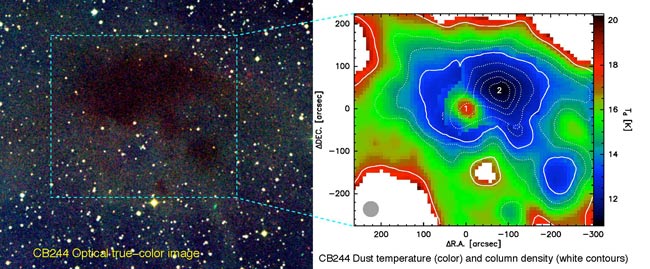Frigid Cloud in Deep Space Gets Its Temperature Taken

An interstellar cloud of gas and dust in deep space has hadits temperature completely mapped across all regions ? a cosmic first ? allowingscientists to pinpoint exactly where baby stars are being born.
The European Space Agency's Herscheltelescope took the temperature of the cloud, called CB244,from its centerto the edge, revealing two hotspots of star-formation inside.
"We cannot measure these temperatures from theground," said Amelia Stutz of the Max-Planck-Institute for Astronomy inHeidelberg, Germany. "That's because the atmosphere blocks thesewavelengths, but Herschel is poised perfectly in space and designed toinvestigate these coldest regions of the universe."
One of the star cradles inside the cloud has a temperatureof minus 427 degrees Fahrenheit (minus 255 degrees Celsius), and Herschel wasable to pinpoint a nascent star. The young star contains 1.6 times the mass ofthe sun.
The other region, which has a temperature of minus 440 degreesFahrenheit (minus 262 degrees Celsius), is so young that a star has yet to evenform. Instead, there is just a collapsing core of gas and dust that willeventually become a hot star. This collapsing region contains between three andseven times the sun's mass.
This new temperature map also allowed astronomers tocalculate the amount of matter inside the star-formingcloud.
Overall, astronomers calculated that the cloud is between 10and 20 times the sun's mass, which means that almost half of its total mass isinvolved in forming the two stars.
Get the Space.com Newsletter
Breaking space news, the latest updates on rocket launches, skywatching events and more!
Herschel's observations also showed that the cloud'stemperature rises toward the outer edges, which reveals that the light from thesurrounding stars is heating up the cloud's outer faces.
Herschel,built by ESA, launched in May 2009 on a mission to scan the universe in thefar-infrared range of the spectrum.
- Images- Spectacular Nebulas
- Video- The Herschel and Planck Missions
- Bigger,Better Space Telescopes Following In Hubble's Footsteps
Join our Space Forums to keep talking space on the latest missions, night sky and more! And if you have a news tip, correction or comment, let us know at: community@space.com.

Space.com is the premier source of space exploration, innovation and astronomy news, chronicling (and celebrating) humanity's ongoing expansion across the final frontier. Originally founded in 1999, Space.com is, and always has been, the passion of writers and editors who are space fans and also trained journalists. Our current news team consists of Editor-in-Chief Tariq Malik; Editor Hanneke Weitering, Senior Space Writer Mike Wall; Senior Writer Meghan Bartels; Senior Writer Chelsea Gohd, Senior Writer Tereza Pultarova and Staff Writer Alexander Cox, focusing on e-commerce. Senior Producer Steve Spaleta oversees our space videos, with Diana Whitcroft as our Social Media Editor.









